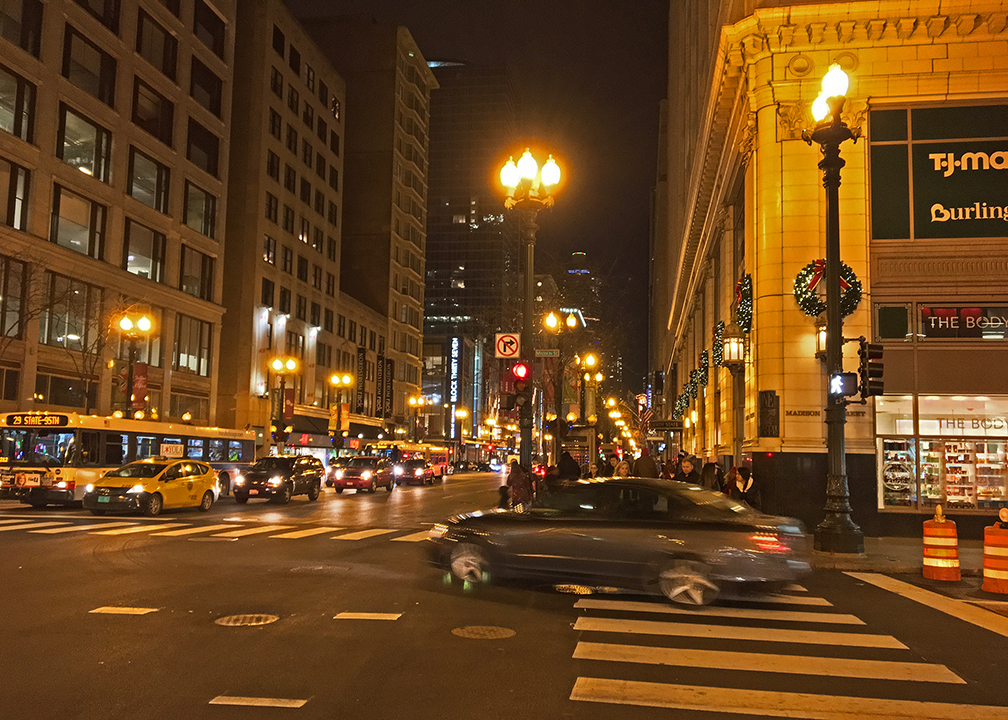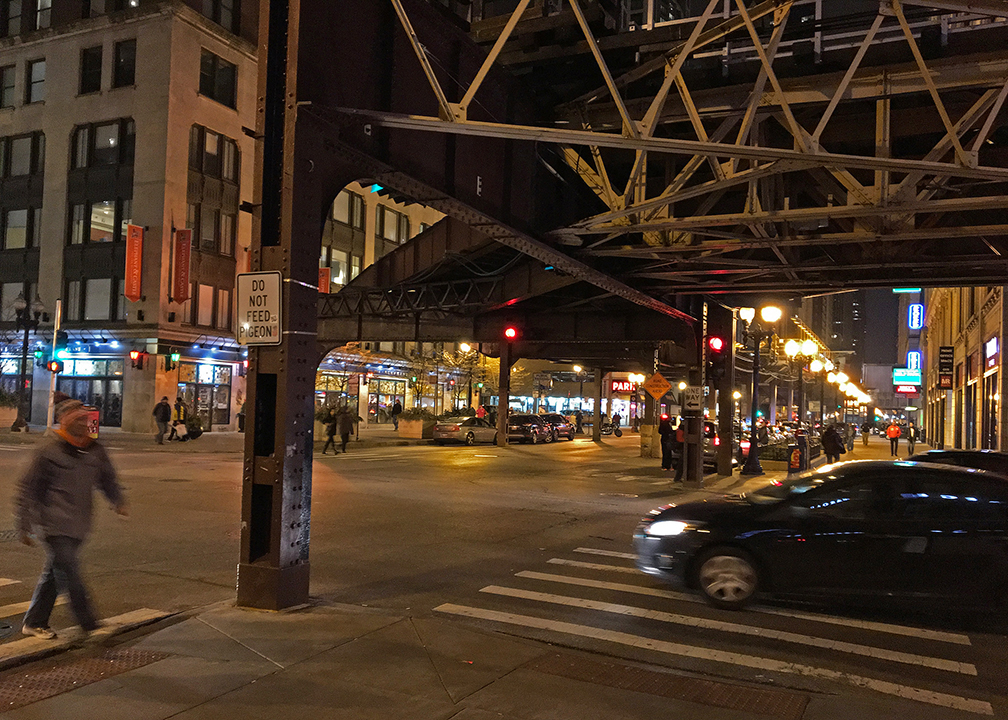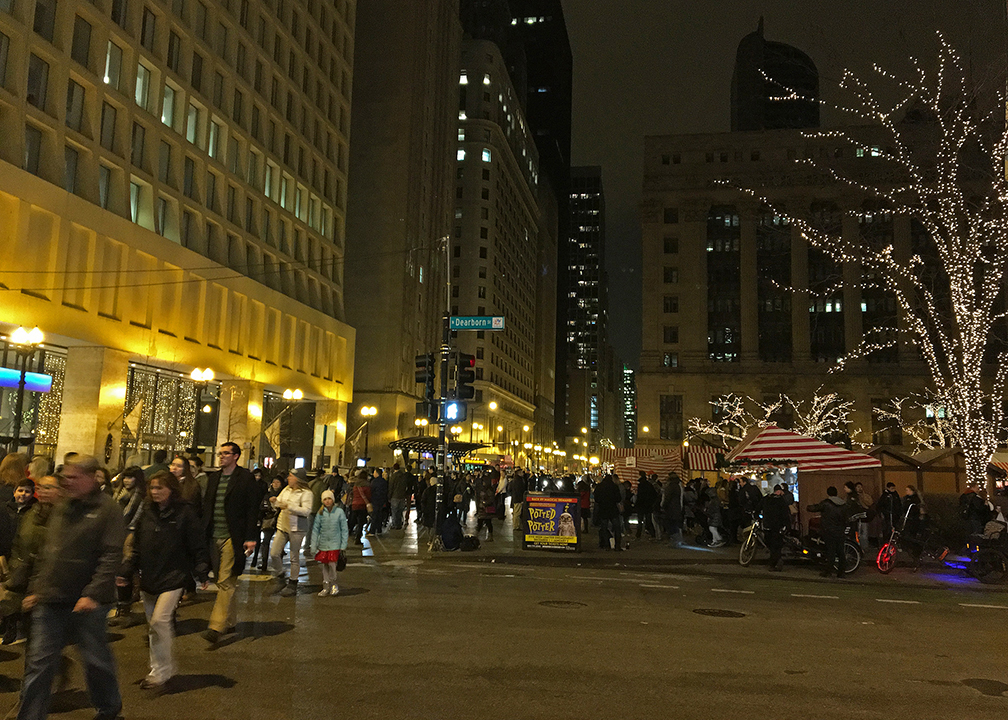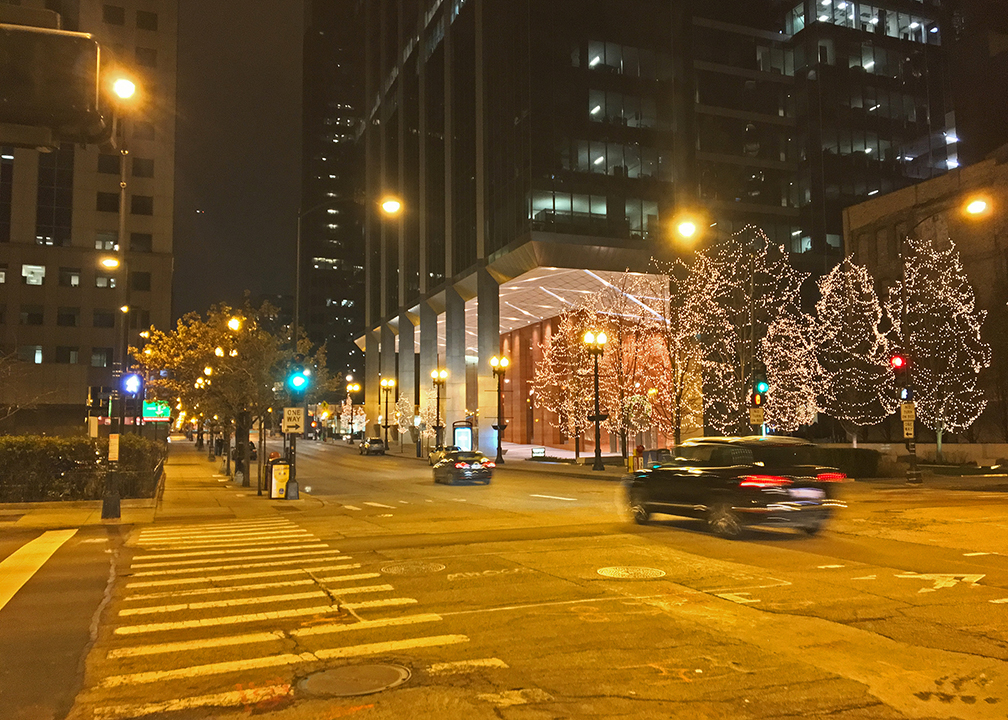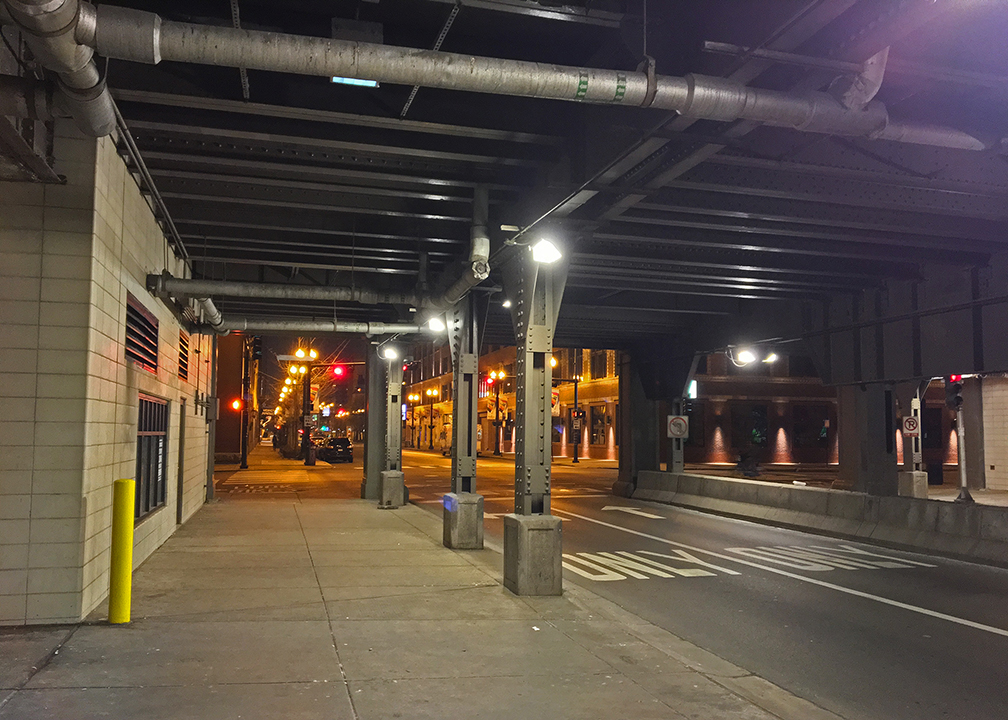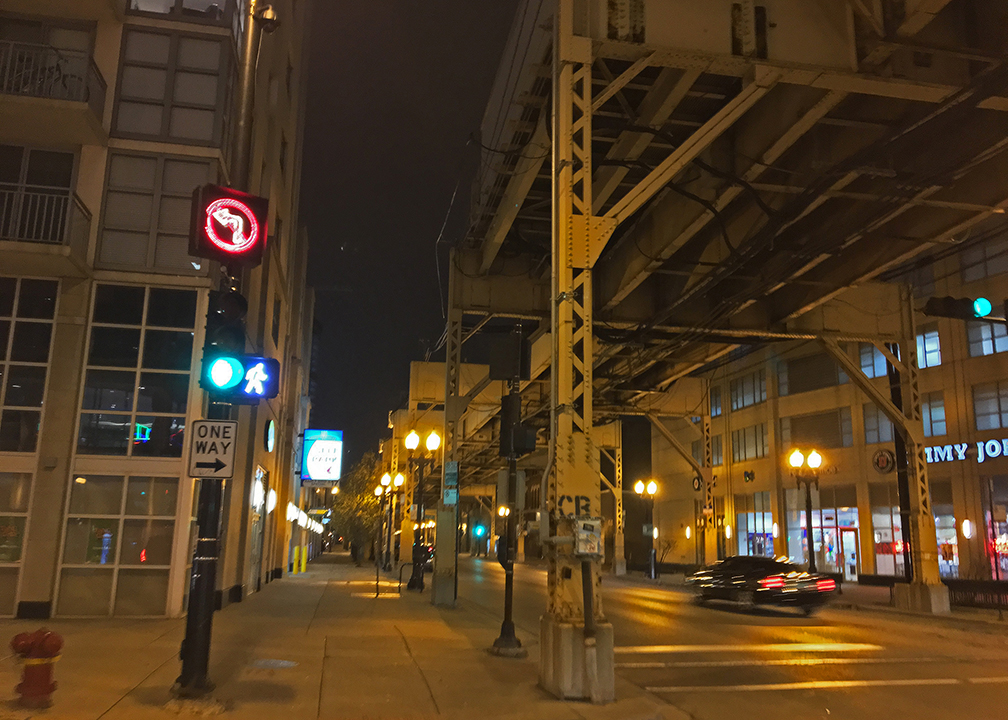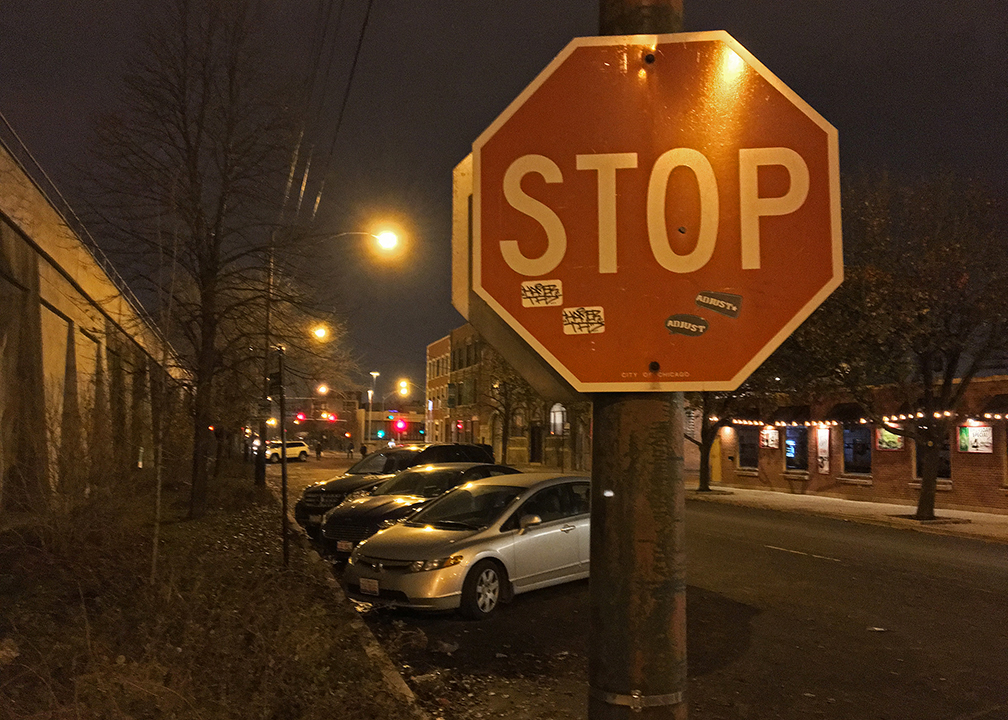walking through "following the light: a pedestrian signal derive"
Here you will find an online, accessible copy of a written work-in-progress intended to help contextualize and theorize the Following the Light project. The following essay was written in conjunction with a course taught by Lori Waxman at The School of the Art Institute of Chicago, called "Walk That Way." The essay is currently under revision and will be included as a chapter to a longer project by the artist. As such, the artist retains all rights to this work and text. While reading is encouraged, please do not copy, distribute, or use the text without the artist's explicit permission (which may be granted by contacting through the website). Check back with news about future publications.
Walking Through
Following the Light:
A pedestrian signal dèrive
Jordan Miller
May 12, 2016
Walking through Following the Light: A pedestrian signal dèrive
The twinkling of cities at night always says to me, look at us as a species, this is what we do.
-The City Dark
At certain times I have preferred walking, that is to say walking with my feet, to talking, that is to say walking with my mouth—but in the end it is the same thing.
-Serge Daney
There’s a way the artificial lights and natural darkness of nightwalks turn the day’s continuum into a theater of tableaux, vignettes, set pieces, and there’s always the unsettling pleasure of your shadow growing and shrinking as you move from streetlight to streetlight.
-Rebecca Solnit, 319
We are slowed down sound and light waves, a walking bundle of frequencies turned into the cosmos.
-Albert Einstein
Walking from the center of the city, follow the path indicated to you by lit pedestrian crossing signals.
The experiences resulting from following the above walking score are immensely variable. Outcomes could range from looping back in on one’s path for hours on end to miles of zigzagging across the city fabric. Each possibility is dependent on an indeterminate reading of light signs, constantly in flux, dispersed throughout the urban environment. Following the Light: A pedestrian signal dèrive, as an artwork, represents an epistemic and conceptual break in my own artistic practice. This change came about as my interest and focus shifted from experimenting with light as a medium, typically within an art setting, to an examination of light as relational and an unavoidable and increasing aspect of our lived, contemporary existence. This essay seeks to contextualize Following the Light within a history and lineage of walking art, specifically with regards to the dèrive. It will also walk through the piece in order to forge a trail of thought through the theoretical and lived light environments of the urban reality.
As my interest in light shifted from its potentiality as a material for use in an isolated art setting to a more open engagement with our actively lived and constructed light environments, so too did my artistic practice begin to shift from the studio to the city. Following the Light was one of my first attempts to have work navigate a different path in relation to light and how we actively experience it on a daily basis. It was conceived of alongside three other works: OPEN (for), a found neon open sign; The stars seen from Chicago, a series of projections based on photographs and videos of city lights that appear to take on the quality of stars in the night sky (the stars themselves unseen thanks to abundant light pollution); and North State, a documentation of all of the text and language observed as light along Chicago’s North State Street on the evening of December 1, 2015, recorded in print in a small book. Of the four new works that marked this fork in the road for my practice, two were heavily involved in the activity of walking. Even the other two required it on some level.
But why is this connection between walking and light so crucial, so important? In truth, there is no simple answer. The reality of our contemporary existence, however, reveals a world awash in light, both natural and artificial, from the micro to the macro level. From the tiniest diodes that work collectively to project an image on the screen of a phone in a hand or pocket, to the street lights that mark our cities on the globe and make our presence visible from space, there is little human activity left that does not play some role in our complex and unfathomably nuanced relationship with light. As Richard Wentworth wrote, “The world is made of light” (245). We are immersed in light. We wade and walk through it on a daily basis.
But our relationship to light wasn’t always this intense.
Lighting the Path
Only about two centuries ago, streets were barely lit, if at all. As noted by Rebecca Solnit in her book Wanderlust: A History of Walking, “walking along the public roads often signified that one was either a pauper or a footpad, at least until the 1770s, when various intellectuals and eccentrics began to walk there for pleasure. By the late eighteenth century, the roads were improving in both quality and safety, and walking was becoming a more respectable mode of travel” (156). This change in the attitude toward walking on public roads, though, arguably has less to do with the characters who came to frequent the streets and more to do with the lighting and subsequent perceived safety of those streets. Particularly in cities, where the enjoyment of nature doesn’t hold as a motivating factor for a leisurely stroll, being in the streets, especially after dark, caries with it a whole host of other meanings. “Urban walking has always been a shadier business, easily turning into soliciting, cruising, promenading, shopping, rioting, protesting, skulking, loitering, and other activities that, however enjoyable, hardly have the high moral tone of nature appreciation” (Solnit, 317).
Prior to the lighting of cities, “darkness, pitch black and impenetrable, was the realm of the hobgoblin, the sprite, the will-o'-the-wisp, the boggle, the kelpie, the boggart and the troll” (Henley). But beyond the hollow threat of superstitions, there was the very real danger of criminal activity. Solnit points out that “cities often imposed a curfew and closed their gates at sunset,” and that “going out anywhere at night was as dangerous as the worst slums are supposed to be nowadays, and if you wanted to see where you were going, you hired a torchbearer” (323). The prospect of publicly lit streets was not unheard of or even new. Accounts as far back as ancient Egypt and Syrian Antioch record some form of lanterns hung in public streets (Luckiesh, 153). Yet these efforts were limited and isolated, often only utilized at significant times, and never well organized or sufficient to democratize the whole of a city and its streets.
In 1417, London began requiring its citizens to hang lanterns outside their doors over the winter, “betwixt Hallowtide and Candlemasse” (Luckiesh, 154). This practice was not well enforced and only taken up in a few other European cities, such as Paris. An improvement in lantern making, however, swept through Europe. Paris adopted widespread street lighting by 1667, with Amsterdam following in 1669, and Berlin in 1682 (Isenstadt, et al, 67-8). For over a hundred years, these relatively provisional methods for lighting the streets expanded and contracted, flashed and burned out. The overall approach changed little, with improvements revolving around the designs of lamps rather than distribution and funding. Most public light came from the combination of candles or lamps in private windows or doorsteps and the few sparse lanterns hung in very select (and typically affluent) streets. Candles were burned in most homes, as well as animal fat and oils mixed with tinder. Similar oils and coal extracts were used in some of the street side lamps.
In 1807, London became the first city to install a system of public gas lights, marking the true start to “public-service lighting” (Luckiesh, 157). Berlin was lit with 1,800 gas lights by 1829 (Isenstadt, 68). These attempts at a more organized, efficient, and structured means of lighting the streets was “almost invariably the result of an attempt to reduce the number of robberies and other crimes” (Luckiesh, 156). Not everyone welcomed the new light, however. Many municipalities and citizenries saw the systems as too expensive and unnecessary, while others voiced concerns that the “fear of darkness will vanish and drunkenness and depravity increase” (158). Taxation to pay for installment and maintenance, as well as laws protecting the lamps or requiring citizens to contribute their own lanterns all added to the frustration. Public lighting also tended to be segregated and exposed activities many would rather keep concealed under the cloak of darkness. Those resisting the change held that “public street lighting threatened the traditional night life and political order…on city streets at night the work, leisure, and social representation patterns of courtiers, burghers, and youth could collide violently” (Koslofsky, 155).
As Baron Haussmann unrolled his plan for Paris and reshaped its architecture, streets, and layout (Solnit, 371), he made a point of including expansive infrastructure for public lighting. “Street lighting was, self-evidently, a powerful weapon of both economic and social control, and in the urban riots that swept much of Europe in the 1830s and 40s,” street lights would fall victim to vandalism, or in the case of Paris, even be used as impromptu gallows (Henley). This turbulent relationship with the introduction of street lighting continued, but slowly lost momentum as the practice of lighting urban spaces became more common and widespread. Despite the dissension, it could be seen that “with the introduction of public lighting and the improvement of the night watch, the streets of Paris, London, and other European cities seemed safer and more convenient to use, while the evening became a more important part of the respectable social day” (Koslofsky, 163).
World's Columbian Exposition, Chicago 1893
The invention and reliable distribution of electricity further changed the situation surrounding artificial lighting. Paris held the first demonstration of temporary electric lighting in 1878 (Isenstadt, 68-9). The following year Thomas Edison would file patent US 214636 A for an “Improvement in Electric Lights” (Edison) and create the first commercially viable, and mass-producible electric, incandescent light bulb. A year later, “on the evening of March 31, 1880, Wabash became the first electrically lighted city in the world” (Wabash, IN), with the successful demonstration, purchase, and installment of four arc lamps on high towers near the Indiana city’s center. Then, on October 10, 1881, London’s Savoy Theatre would open as the world’s first public building lit entirely by electric, incandescent lighting (Savoy Theatre). The next year, 1882, saw the installment of the “first significant network of electric street lights” in Berlin (Isenstadt, 69).
Just over a decade later, the modernized phoenix of Chicago had risen from the ashes to host the 1893 World’s Fair and take full advantage of the opportunity to expand its public lighting. The Colombian Exposition was lit by at least 93,000 incandescent bulbs (Bach, 324). Reports from the Department of Commerce indicate that the number of incandescent street lamps doubled between 1912 and 1917, increasing from 681,957 to 1,389,382 (Luckiesh, 162). Philadelphia’s 1926 Sesquicentennial “boasted elaborate lighting effects,” and Chicago’s 1933 Century of Progress World’s Fair “dazzled visitors with experiments in light and color, including unprecedented ‘floods’ of light produced by gaseous tubes (neon); the Hall of Science, for example, incorporated the largest number of neon tubes that had ever been used on any one surface” (Bach). New York’s 1939 World’s Fair, World of Tomorrow, emphasized the showcasing of artificial light with the “use of newly perfected fluorescent light applied to everything from buildings and pylons to the backlighting of sculpture and murals” (Bach). The advancement of public lighting only quickens from there.
Still, with regards to the original goal of public safety, how effective has the past two hundred years of lighting the streets been? How effective is it now? One recent study in Chicago, for the Chicago Department of Transportations, “found that street light outages have different effects on different neighborhoods.” Some saw no measurable change, “other neighborhoods, meanwhile, saw crime rates increase as much as 134 percent when street lights were out” (Riggs). Many extensive studies have been conducted, with little clear consensus or consistency in results. Those studies that include follow up surveys measuring public opinion before and after public lighting improvements, however, show that despite any actual fluctuations in crime rates, people do feel safer on streets that are more adequately lit at night. “Lighting increases a sense of community, and community pride. It brings us outdoors in our neighborhoods, helps us get to know each other. Fear keeps us out of the alley, and attraction to light and what it represents draws us to illuminated streets” (Riggs). And it is in these illuminated streets that we walk.
Two Accounts of the Dèrive
From the emergence of the Modern flâneur, “that ephemeral character who…killed time by enjoying manifestations of the unusual and the absurd, when wandering about the city,” (Careri, 73) and onward, walking has been used to varying extents in many artistic practices. It is arguably the Dadaists who took “the first step in a long series of excursions, deambulations and ‘driftings’ that crossed the entire century as a form of art” (70). The Surrealists, led by André Breton, would continue this legacy, with an emphasis on photography and written accounts of walks in particular. Between the walks of these two groups “the action of passing through space was utilized as an aesthetic form capable of taking the place of representation, and therefore of the art system in general” (70). In the 1950’s, the Letterist International, turned Situationist International, “saw getting lost in the city as a concrete expressive possibility of anti-art” (89). The resulting dèrive, or “drifting,” was “the construction and implementation of new forms of behavior in real life, the realization of an alternative way of inhabiting the city,” and an investigation of, what they termed, the city’s psychogeographic contours and the ways in which the urban fabric impacts its pedestrians and citizens(90).
Guy-Ernest Debord offered his understanding of the dèrive in his Theory of the Dèrive in 1956. He describes the dèrive as a “technique of rapid passage through varied ambiances” that involves “playful-constructive behavior and awareness of psychogeographical effects.” One must “drop their relations, their work and leisure activities, and all their other usual motives for movement and action, and let themselves be drawn by the attractions of the terrain and the encounters they find there.” The space explored during a dèrive “may be precisely delimited or vague, depending on whether the goal is to study a terrain or to emotionally disorient oneself.” The drifts attempt to facilitate the “discovery of unities of ambiance, of their main components and their spatial localization, one comes to perceive their principal axes of passage, their exits and their defenses.”
In Two Accounts of the Dèrive, Debord goes on to describe in detail two executions of such a walk. One account, “Encounters and Difficulties Following an Extended Dèrive,” recounts drunken nights at Algerian bars and odd and disorienting occurrences over several nights of their drinking and drifting. The second account, “Gathering Urban Ambiances by Means of the Dèrive,” offers a more specific and focused investigation of a walk through the city, noting their perceived psychogeographic zones, specific attractions and deterrents, as well as possible improvements for repeating the dèrive to learn even more. We can see by these two accounts, in supplementing his Theory, that at its most basic, the dèrive “is a bodily labor that produces nothing but thoughts, experiences, arrivals” (Solnit, 19). These experiences, then, can be used to investigate, explore, and better understand the urban context and environment.
Following the Light functions very much as a dèrive, “every walk a tour leisurely enough both to see and to think over the sights, to assimilate the new into the known” (Solnit, 20). It seeks to tap into the general collective boundaries and access points granted by a certain institutional light network distributed throughout the city. It is a dèrive that finds at its core that “light reveals the world and the ways we try to regulate it.” (Wentworth, 245). And, as with the Letterist dèrive, the constant change in the city as you drift through it may result in a sense of disorientation (Careri, 95). Also, similar to the Situationist dèrive, “to play means deliberately breaking the rules and inventing your own,” (106) though in the case of Following the Light, the system of lit pedestrian crossing signals is broken by the act of actually following them and their rules very literally, to the point of their loss of usual functionality and alteration of use that results, not in suggested safe passages on a planned route, but in following an open conduit of light signs in order to loose oneself in the city. Indeed, as a dèrive, Following the Light “tends to promote all sorts of new forms of labyrinths made possible by modern techniques of construction” (Debord). The construction here being the network and system of lit pedestrian crossing signals. It utilizes “the indeterminacy of a ramble, on which much may be discovered,” (Solnit, 28) to break free of “the sensory deprivation chambers of apartments and offices” (58), and in my own artwork, the sensory deprivation chamber of the studio and the more ambient terrain of much light art (Turrell’s work acts as little more than gallery size sensory deprivation chambers while offering the suspicious pretense of an intense spiritual experience with light-even going so far as to use actual sensory deprivation chambers).
Taking the aforementioned writings by Debord collectively as “one account,” I offer a second account of the dèrive, undertaken in completion of Following the Light. Such an account might read as follows:
On the evening of December 6, 2015, I began walking north from State Street and Madison Street in Chicago, following the path indicated to me by lit pedestrian crossing signals. The long corridor of light that was State Street glowed its usual pumpkin-color, but carried the additional ornamentation of Christmas lights, wreathes, and holiday decorations. The light sculptures along the sidewalks, likewise oscillated red, green, white, and blue. Practically every window had festive displays and created even more light that spilled out onto the sidewalk and feet. It was a Sunday night, but the unusually warm start to the season and holiday events and specials drew out more people than usual. From the beginning the air smelled like Garrett’s popcorn. The Chicago mix with the caramel and cheese. I passed store after store, and an excessive number of Gap signs. GAP KIDS. GAP. GAP BODY. GAP. GAP. baby GAP. GAP GAP.
Continuing north, the next block was dominated by Block 37 and Macy’s with its holiday window displays and the throngs of people they attract. It was difficult to navigate through the crowd some moments, and the sound of chatter and holiday music was only cut by the occasional call from a homeless individual for spare change.
Still heading north, I passed on the next block (awash in light from the theatre signs and marquees, LED signboards and text scrolls, neon, and light boxes scenographically attached to the architecture) the Chicago Theatre, Gene Siskel Film Center, ABC7, ESPN, Sleepy’s, and Chic-fil-a. You could smell the chicken, along with the slight smell of chocolate carried on the wind from the Bloomers factory. It was the intense concentration of light on this block that strikes me the most. The crowd wasn’t as dense or stubborn as the previous block, but still fairly thick none-the-less.
With no clearance to cross, I turned east on Lake Street, the steel struts of the L lines acting as a sort of dark arcade to pass along. The number of people dropped significantly, as did the adornment of architecture and levels of light. With few pedestrians, most individuals encountered were tucked into nooks by storefronts or at the mouths of alleys smoking. I turned north on Wabash, the skyline opening up as I passed from under the tracks and through the last stretch of buildings before the river carved a canyon through them. The pinnacles and spires of Chicago’s skyscrapers and historic buildings were light red, green, and white. I turned west along Wacker Drive, passing the Jeweler’s Building and into the chill of the wind that cut through the urban gorge. The sky was more visible here than any other point on the walk so far, but the wind made it significantly cooler and the sounds of people, music, and trains gave way to the low rumbling hum of cars on Upper and Lower Wacker. The smell of chocolate came and went with each breeze.
I turned back south on State, passing the Wit and some empty space usually set up for street side dining. I passed back under the L to continue south on State, turning back in on my previous path (but in the opposite direction). Once I had traversed the spectacle around the Chicago Theatre again, I followed the light west on Randolph Street. The movement of people here was steady and the flow was constant. Another Garrett and more popcorn smell. This smell quickly gave way to the smell of mulled wine, cider, and a miriad of German foods as I turned south on Dearborn and walked in the direction of Daley Plaza and the seasonal Kristkindl Market. I passed the other end of Block 37 before turning west on Washington Boulevard.
I skirted the south edge of Daley Plaza and the Market. The trees here were strung with webs of lights and Picasso sculpture was surrounded by the tents and booths, smells and sounds. People filled in the remaing space of the plaza and spilled out onto the surrounding sidewalks. It truly smelled delicious and the light and sound would have easily been enough to draw most people in. It was a holiday phantasmagoria, more welcoming than the more corporate and ad-oriented displays at Macy’s. I turned north on Clark, passing City Hall and the market’s porta-potties. The smell was less pleasant here. I turned west again, on Randolph, between City Hall and the Thompson Center. The number of people was again, significantly lower.
Continuing west another block, however, brought more people and a small crowd gather outside the Cadillac Palace Theatre. There were quite a few children in the group, there to see a performance of the Lion King. Most seemed eager and excited for their evening. Walking still west on Randolph, the people quickly dissipated but the webs of light in trees remained. Still further west, the holiday displays grew much less frequent and the sight of people was occasional as the financial district proved to draw little interest for most people on the weekend. I turned south onto Wacker Drive and continued alone for a block. I could hear a conversation down a nearby alley, but saw little activity otherwise until turning west on Washington and passed the Lyric Opera. I crossed the Chicago River via the Washington Boulevard Bridge along with a scant few people heading toward the Metra station. The skyline view was excellent, but again, the wind cut sharper with a chill that wasn’t felt between the shoulders of the buildings.
I turned, following the lit pedestrian signals north on Canal Street. This was the first significant change in the quality of the sidewalk and street lighting. The path was far narrower and slightly uneven in comparison to the Loop, and it was quite a bit darker with fewer lights. There was a single man talking on his cell phone and smoking a cigarette, leaning against a wall. I then turned west on Randolph, and was totally alone walking through a tunnel underneath train lines. Here, high-pressure sodium streetlights gave way to more industrial fluorescent tubes and mercury vapor lamps. The tunnel hummed a bluish-green haze. A small bakery, closed, was tucked away in the duct. Still walking west, I emerged from under the tracks and back into the pumpkin-glow of Chicago’s signature streetlights.
I followed the light north on Jefferson Street, passing a few bars and restaurants in an old warehouse area. There were people again, but significantly fewer than in the Loop. I entered the arcade under the L again as I turned west for a block on Lake Street, walking by a few sparsely populated fast-food chains and coffee shops.
I then turned north onto Desplaines Street. The street lighting again became less frequent and bright and the sidewalks narrowed and buckled here and there. A few individuals carried grocery bags or zipped by on bicycles. The path inclined as it made its way ever so slightly uphill. I crossed over train tracks by way of an overpass and beyond a brightly lit parking lot, the most expansive I had encountered on the walk. The hum of the nearby expressway was now very discernable and audible. Heading downhill, more sharply than the uphill climb, I came to the five-point intersection of Desplaines, Milwaukee Avenue, and Kinzie Street. I passed a small park and kept north on Desplaines.
The sidewalk all but disappeared, along with streetlights, after crossing Kinzie. What sidewalk there was had been broken up and disintegrated into chunks scattered among tufts of weeds and dead grass. I passed by a factory (Bloomer’s to be exact, though they had not been emitting the smell of chocolate since I started the walk) and headed underneath the rail line. It was very dark and I was the only one walking for at least another block or two. After coming up from under the track, the sidewalk ended completely at a stop sign on Hubbard Street. There was no more light to look to or follow. Across the street the sidewalk started again, in front of City Pool Hall. I will be sure to return to this bar at some point.
Following Following the Light
The idea for Following the Light came to me shortly after reading Christof Migone’s “I Think, Therefore I Follow: The Sequitur Principle in Contemporary Conceptual Practices.” The Serge Daney epigraph comes from this essay, where Migone reveals that it “comes from an essay on Robert Walser, where it is also used as an epigraph” (18). It only follows that it would make an appearance in my own examination. “Here it is again: ‘At certain times I have preferred walking that is to say walking with my feet to talking that is to say walking with my mouth—but in the end it is the same thing’” (Migone, 18). The essay follows Vito Acconci’s Following Piece (1969) and Thérèse Mastroiacovo’s Following Following Piece (2008-10), and begins by establishing the premise that “walking opens an active discursive space, one where standing still on the sidelines is not an option” (18). It is this potential for discourse and direct engagement that planted the seed for walking to grow into an important aspect of my own work. After all, “walking is about being outside, in public space, and public space is also being abandoned and eroded in older cities, eclipsed by technologies and services that don’t require leaving home, and shadowed by fear in many places (and strange places are always more frightening than known ones, so the less one wanders the city the more alarming it seems, while the fewer the wanderers the more lonely and dangerous it really becomes)” (Solnit, 28).
Vito Acconci's ollowing Piece, 1969
In his essay, Migone also tells of Acconci’s performance of Standing, the day before the opening of Street Works IV, for which Following Piece was completed. For this piece, the artist stood by the traffic light on the corner of 65th Street and Madison Avenue for the duration of the opening (21). Standing acts as an “opening upon an opening” (22) and engages with the flow of pedestrian traffic in a way counterpoint to Following Piece. This “opening,” though, was of particular interest to me. When thinking about walking and light, there was an obvious sign of the relationship between the two: the lit pedestrian crossing signal. These signals act as openings for conduits of bipedal passage from one side of the street to another, like bridging circuits for the flow of electricity. Through Following the Light, the drifter must give up their agency to movement and follow the path of least resistance, to speak (and act) in terms of electrical impulse.
The lit pedestrian crossing signals also act as an active intersection and crossing between the theoretical, or “Concept-city,” and the actual, lived city. As De Certeau defines it, the Concept-city is “a place of transformations and appropriations, the object of various kinds of interference but also a subject that is constantly enriched by new attributes, it is simultaneously the machinery and the hero of modernity” (95). The Concept takes form in maps, aerial views, and abstractions of the city through statistics and systems. The lived city is acted out and constructed on the streets. These “pedestrian speech acts” are described as “a spatial acting-out of the place (just as the speech act is an acoustic acting-out of language); and it implies relations among differentiated positions” (98). The relations between walking, light, the city, and “these apparatuses that produce a disciplinary space” (96) are under investigation in my work.
In writing the score for Following the Light, I strove for something similar to the instructions for Acconci’s work where the “work is structurally determined but performatively undetermined” (Migone, 19). The work similarly finds “pedestrian traffic is deployed as…compositional tool” (21). I also looked to the work of Fluxus artists and their walk scores and Flux Kits in particular. Yoko Ono served as a good model. It was partially through this influence that I decided upon the postcard as a means of distributing the score. It bridges the gap, however, between the Fluxus score and the dèrive by including on the back a key for the score and an email address to which one can send their own documentation and accounts of the dèrive. These records are published onto a page on my artist website dedicated to the project. As an archive of various dèrives across, potentially, many different cities manifests, a closer examination of the movement afforded by the network of pedestrian lights across urban contexts may reveal fun and surprising results as well as a better understanding of how such systems contribute to the collective feeling of cities and their affects on those living in and navigating those spaces. Through such a dèrive, “an urban walker may note a grocery open late or a place to get shoes resoled, or detour by the post office…The urbanite is on the lookout for particulars, for opportunities, individuals, and supplies, and the changes are abrupt.” (Solnit, 318). One may also become more aware of their relationship to light, both natural and artificial, and how we distribute and build up light apparatuses throughout our constructed light environment.
In a context where cities like Chicago produce excessive levels of light pollution, confusing birds and wildlife, but exhibit a demand for well-lit thoroughfares, how do we respond? What does it say that the “distinct differences” between Berlin’s “eastern and western halves are still clearly visible—twenty-four years after the wall came down. The west appears as a luminous web with bright clusters, while the east shows darker orange lines and few bright spots” (Isenstadt, 67)? As we progress we begin to understand that “when we add light to the environment, it is an alteration of habitat” (The City Dark). The advent of such light environments is still relatively fresh, and the ultimate outcomes are yet to be seen or determined.
Our conquest of the night is something to be celebrated and scrutinized simultaneously. We must enjoy, live, and engage with our new light, but we should also be critical and open to adaptation. We should seek to understand our relationship to light better and more clearly. But such knowledge won’t come through abstract discourse alone. The dialogue of light takes place on the city streets at night just as much as in the interior space, arguably more. What better way to know that relationship better, and contribute more to the conversation, than to get out and walk in the light, to engage with and experience it?
Walking, witnessing, being in public, are as much part of the design and purpose as is being inside to eat, sleep, make shoes or love or music. The word citizen has to do with cities, and the ideal city is organized around citizenship—around participation in public life…Walking is only the beginning of citizenship, but through it the citizen knows his or her city and fellow citizens and truly inhabits the city rather than a small privatized part thereof.
-Rebecca Solnit, 321
Bibliography/Works Cited
Bach, Penny Balkin. 1989. “To Light up Philadelphia: Lighting, Public Art, and Public Space.” Art Journal. vol 48, no 4, Critical Issues in Public Art (Winter, 1989). 324-30. College Art Association. Print.
Careri, Francesco. Walkscapes: Walking as an Aesthetic Practice. Barcelona: Editorial Gustavo Gili, 2007. 119-126, 142-154. Print.
The City Dark. Dir/Prod. Ian Chaney. Edgeworx Studios, 2011. Film.
Debord, Guy-Ernest. “Theory of the Dérive (1956).” Internationale Situationniste #2. Trans. Ken Knabb. 1958. Nothingness.org. Web. <http://library.nothingness.org/articles/SI/en/display/314>.
Debord, Guy-Ernest. “Two Accounts of the Dérive (1956).” On the Passage of a few people through a rather brief moment in time: the Situationist International 1957-72. Ed. Elisabeth Sussman. Cambridge: MIT, 1989, p. 135-9. PDF.
De Certeau, Michel. “Walking in the City,” The Practice of Everyday Life, translated by Steven Randall. Berkeley: University of California Press, 1984. 91-110. PDF.
Edison, Thomas A. “Improvement in electric lights.” US Patent 214636 A, filed October 14, 1878, and issued April 22, 1879. Patent- electronically accessed.
Henley, Jon. “Life before artificial light.” The Guardian. October 31, 2009. Web. May 2, 2016. <http://www.theguardian.com/lifeandstyle/2009/oct/31/
life-before-artificial-light>.
Image: Acconci, Vito. Following Piece. 1969. Contemporary Art Daily. <http://www.contemporaryartdaily.com/2014/05/
69-96-at-gebert-foundation/1969followingpiece3/>.
Image: "World's Columbian Exposition: Administration Building, Chicago, United States, 1893", 1893. Brooklyn Museum Archives. Goodyear Archival Collection. (Photo: Brooklyn Museum, S03i2152l01_SL1.jpg) <http://cdn2.brooklynmuseum.org/images/opencollection/archives/size2/S03i2152l01_SL1.jpg>.
Isenstadt, Sandy; Maile Petty, Margaret; Neumann, Dietrich. Cities of Light: Two Centuries of Urban Illumination. New York: Routledge, 2015. Print.
Koslofsky, Craig. Evening’s Empire: A History of the Night in Early Modern Europe. New York: Cambridge University Press, 2011. Print.
Luckiesh, M. Artificial Light: Its Influence Upon Civilization. “Lighting the Street.” New York: The Century Company, 1920. 152-162. Print.
Migone, Christof. “I Think, Therefore I Follow: The Sequitur Principle in Contemporary Conceptual Practices.” WOOD TWO. Ed. Christof Migone. Mississauga: Blackwood Gallery, 2012. 16-27. PDF. <http://www.christofmigone.com/html/projects_gallery/
TheSequiturPrinciple.html>.
Miller, Jordan. Following the Light. 2015-16. Postcards, walking score, photographic documentation, text, and maps. <jordanmillerart.com/followingthelight>.
Riggs, Mike. “Street Lights and Crime: A Seemingly Endless Debate.” CityLab. The Atlantic. February 12, 2014. Web. May 6, 2016. <http://www.citylab.com/housing/2014/02/
street-lights-and-crime-seemingly-endless-debate/8359/>.
“About the Savoy Theatre.” The Savoy Theatre. Accessed April 27, 2015. <http://www.savoy-theatre.co.uk>.
Solnit, Rebecca. Wanderlust: A History of Walking. New York: Penguin Books, 2000. Print.
Wabash, IN. “History.” The City of Wabash, Indiana. Web. May 7, 2016. <http://www.cityofwabash.com/city-information/history/>.
Wentworth, Richard. “Dear Peter.” Architecturally Speaking: Practices of art, architecture and the everyday. Ed. Alan Read. London: Routledge, 2000. 245-51. PDF.



